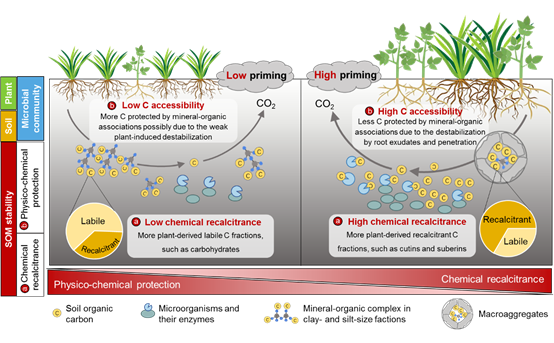Soil is the largest carbon (C) stock in terrestrial ecosystems, with its pool size being determined by the balance between C inputs from plant production and C outputs through microbial decomposition. Of the various plant–soil interactions, the priming effect (i.e. alteration of soil organic matter (SOM) decomposition by labile C inputs) is a key mechanism regulating soil C cycle.
Knowledge concerning the dominant priming driver is crucial for accurately predicting soil C dynamics and the terrestrial feedback to climate warming. However, the role of SOM stabilization mechanisms in regulating the priming effect as well as their relative importance compared with traditional plant, soil and microbial properties have not been identified over broad geographic scales.
A research group led by Prof. YANG Yuanhe from the Institute of Botany of the Chinese Academy of Sciences, revealed the determinants of priming intensity along a 2200 km grassland transect on the Tibetan Plateau by combining systematic field and laboratory analyses. Their findings were recently published online in Nature Communications on November 8, 2019.
In the study, the researchers provided empirical evidence that SOM stability, characterized by chemical recalcitrance and physico-chemical protection, had higher predictive power than other factors in explaining regional scale patterns of the priming effect.
The researchers also pointed out that the priming intensity increased with the proportion of recalcitrant SOM pool and the content of recalcitrant components (e.g. cutin and suberin), but decreased with physico-chemical protection by minerals and aggregates.
These results highlighted the importance of SOM stabilization mechanisms in regulating the soil C dynamics. Future modelling studies should thus consider both SOM chemical recalcitrance and physico-chemical protection to better forecast soil C dynamics under changing environments.
This study was supported by the National Key R&D Program of China, the National Natural Science Foundation of China, the Second Tibetan Plateau Scientific Expedition and Research (STEP) program and the National Natural Science Foundation of China.

Soil organic matter stability, as regulated by plant C input and community composition, determines the priming effect.
Article Link:https://www.nature.com/articles/s41467-019-13119-z
Contact:Email:yhyang@ibcas.ac.cn
Institute of Botany, Chinese Academy of Sciences
Soil is the largest carbon (C) stock in terrestrial ecosystems, with its pool size being determined by the balance between C inputs from plant production and C outputs through microbial decomposition. Of the various plant–soil interactions, the priming effect (i.e. alteration of soil organic matter (SOM) decomposition by labile C inputs) is a key mechanism regulating soil C cycle.
Knowledge concerning the dominant priming driver is crucial for accurately predicting soil C dynamics and the terrestrial feedback to climate warming. However, the role of SOM stabilization mechanisms in regulating the priming effect as well as their relative importance compared with traditional plant, soil and microbial properties have not been identified over broad geographic scales.
A research group led by Prof. YANG Yuanhe from the Institute of Botany of the Chinese Academy of Sciences, revealed the determinants of priming intensity along a 2200 km grassland transect on the Tibetan Plateau by combining systematic field and laboratory analyses. Their findings were recently published online in Nature Communications on November 8, 2019.
In the study, the researchers provided empirical evidence that SOM stability, characterized by chemical recalcitrance and physico-chemical protection, had higher predictive power than other factors in explaining regional scale patterns of the priming effect.
The researchers also pointed out that the priming intensity increased with the proportion of recalcitrant SOM pool and the content of recalcitrant components (e.g. cutin and suberin), but decreased with physico-chemical protection by minerals and aggregates.
These results highlighted the importance of SOM stabilization mechanisms in regulating the soil C dynamics. Future modelling studies should thus consider both SOM chemical recalcitrance and physico-chemical protection to better forecast soil C dynamics under changing environments.
This study was supported by the National Key R&D Program of China, the National Natural Science Foundation of China, the Second Tibetan Plateau Scientific Expedition and Research (STEP) program and the National Natural Science Foundation of China.

Soil organic matter stability, as regulated by plant C input and community composition, determines the priming effect.
Article Link:https://www.nature.com/articles/s41467-019-13119-z
Contact:Email:yhyang@ibcas.ac.cn
Institute of Botany, Chinese Academy of Sciences
